One of the basic things you need to do in Excel VBA is to select a specific range to do something with it. This course will show you how to use Range, Cells, Offset, Resize and Union to select a range in Excel VBA. If you want to learn select all cells that contain a specific type of data, learn this article: Go To Special with VBA.
Using .Select in Excel VBA is a bad habit, learn: How to avoid using Select in Excel VBA.
Select all the cells of a worksheet
Cells.SelectSelect a cell
Cells(4, 5).Select=
Range("E4").SelectIt seems Range() is much easier to read and Cells() is easier to use inside a loop.
Select a set of contiguous cells
Range("C3:G8").Select=
Range(Cells(3, 3), Cells(8, 7)).Select=
Range("C3", "G8").SelectSelect a set of non contiguous cells
Range("A2,A4,B5").SelectSelect a set of non contiguous cells and a range
Range("A2,A4,B5:B8").SelectSelect a named range
Range("MyRange").Select=
Application.Goto "MyRange"Select an entire row
Range("6:6").Select=
Rows("6:6").SelectSelect an entire column
Range("D:D").Select=
Columns("D:D").SelectSelect the last cell of a column of contiguous data
Range("A1").End(xlDown).SelectWhen this code is used with the following example table, cell A3 will be selected.

Select the blank cell at bottom of a column of contiguous data
Range("A1").End(xlDown).Offset(1,0).SelectWhen this code is used with the following example table, cell A4 will be selected.
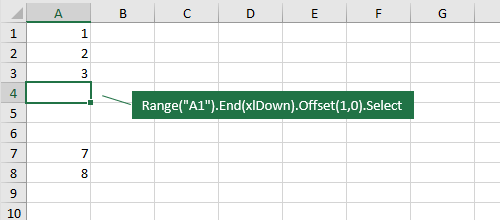
Select an entire range of contiguous cells in a column
Range("A1", Range("A1").End(xlDown)).SelectWhen this code is used with the following example table, range A1:A3 will be selected.
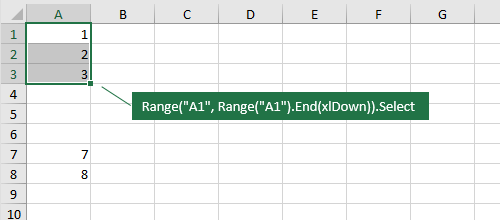
Select the last blank cell in column A
Cells(Rows.count, 1).End(xlUp).Offset(1, 0).SelectWhen this code is used with the following example table, range A9 will be selected.
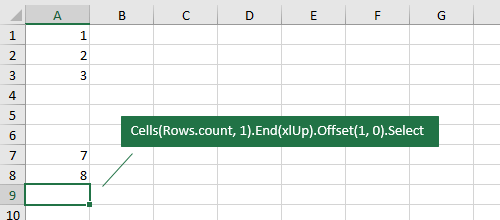
Select an entire range of non-contiguous cells in a column
Range("A1", Range("A" & Rows.Count).End(xlUp)).SelectNote: This VBA code supports Excel 2003 to 2013.
When this code is used with the following example table, range A1:A8 will be selected.
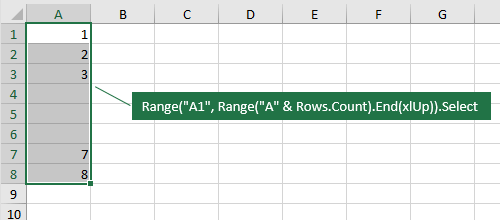
Select a rectangular range of cells around a cell
Range("A1").CurrentRegion.Select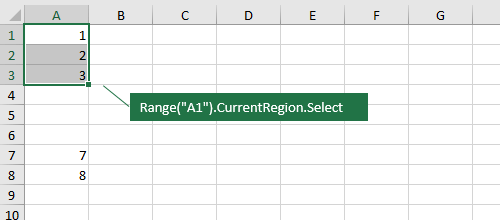
Select a cell relative to another cell
ActiveCell.Offset(5, 5).SelectRange("D3").Offset(5, -1).SelectSelect a specified range, offset It, and then resize It
Range("A1").Offset(3, 2).Resize(3, 3).SelectWhen this code is used with the following example table, range C4:E6 will be selected.
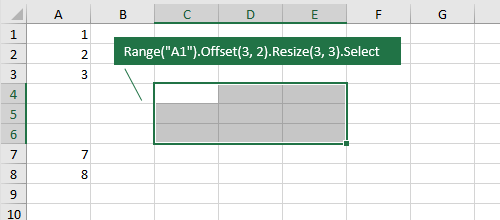
Union of two or more ranges
Union(Range("A1:A8"), Range("D7"), Range("A1:C2")).Select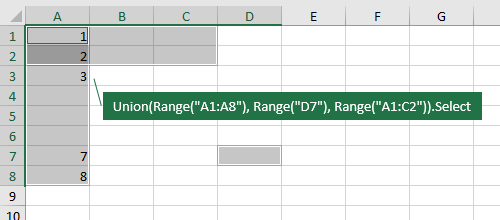
Select used range
ActiveSheet.UsedRange.SelectWhen this code is used with the following example table, range A1:F7 will be selected.
